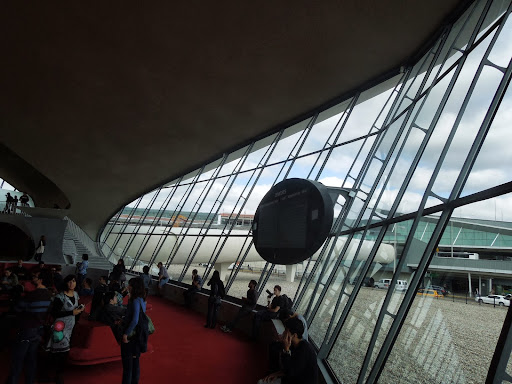Cold War paranoia aside, the future from the perspective of the late fifties was to be an optimistic place. A world of sleek, swooping contours and starlite neon, fishbowl helmets and jetpacks, lunar rovers, moving sidewalks, rocket-powered roller skates, and squelchy theremin-based pop tunes. Unfortunately, economics and politics have since forced us down a grimmer path to where our future likely has more in common with the charred bleakscapes of Blade Runner or Mad Max.
The TWA Flight Center, which opened in 1962 at the airport now called JFK, was the brainchild of Eero Saarinen, a Finnish-American architect who had designed not only the St Louis Gateway Arch, but also the iconic "tulip chair" as seen on the bridge of Star Trek's USS Enterprise. The Saarinen "Head House," as the main structure was called, was a prime example of what is considered Googie or Populuxe architecture, with its thin shell concrete roof, ceramic tiles, and curvilinear mezzanine. The sculptural contours were intended to suggest a soaring bird (though to me it looks more like a Cylon Raider). Predictably, it stirred up the ire of conservative critics of the era, while at the same time winning awards for its bold design. The terminal stayed in operation for four decades until TWA eventually hit the skids at century's end. Since then it has been shuttered to the public, largely, but not entirely, forgotten.
For a few hours on an autumnal Sunday, the good people of Open House New York arranged for the guard dogs to be chained up and the fence de-electrified. Charging down the red carpeted tube which connects the Flight Center to the functional area of the airport, I discovered an open realm of space age contours straight out of The Jetsons. I wasn't alone. The retrofuturist lobby swarmed with history buffs and photohounds, amateur and otherwise, eager to capture this rare sighting.
Technology has progressed at a dizzying pace since the Sixties. A list of devices and developments they couldn't possibly have conceived of then which we now take for granted could fill volumes. In small type with narrow margins. So why does it feel, when gazing around within a stunning time capsule such as this, that they knew something that we don't?
The Flight Center has been listed under the National Register of Historic Places, so fortunately it's not going anywhere soon (unlike the less fortunate UFO-shaped Pan Am Worldport, which lie in ruins as I AirTrained by). JetBlue, who now owns the building, is having it restored but isn't quite sure what to do with the space. Some suggestions bandied about include turning it into a conference center, aviation museum, or restaurant. I believe the current plan is to adapt it as part of a luxury hotel. Make it a tanning salon for all I care, just so long as they preserve this fleeting glimpse of The Tomorrow That Never Was.

18 October 2013
TWA Flight Center
Subscribe to:
Post Comments (Atom)






















No comments:
Post a Comment